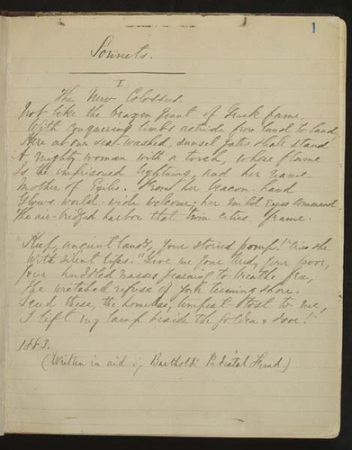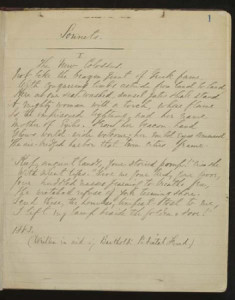
In July, I wrote a post on the first-ever narrative writing course for nursing students at the Hunter-Bellevue School of Nursing. CHMP poet-in-residence Joy Jacobson and I taught the five-week course, which met twice each week for three hours per class. I’m happy to report that it was a great experience for us as instructors and, by the end of the course, the consensus among students was that they didn’t want the class to end.
Eleven nursing students were enrolled and one Hunter staff member audited the course; seven of the 12 participants were not native English speakers (their first languages were Mandarin, Korean, Russian, and Yoruba). Most had done little writing for themselves and all needed to improve compositional and grammatical skills. Nevertheless, all of the students produced creative and moving original writing in a variety of formats, including in-class exercises, blog posts, and personal essays.
Several readers of my previous post asked for more particulars about our teaching methods. Here I’ll focus on the in-class writing exercises.
We spent about the first half hour of each class on one or more “quick writes”—guided writing exercises designed to get everyone writing quickly and spontaneously, without concern for the rules of grammar, spelling, and punctuation. The ideas for the quick writes came from several sources, and we adapted freely from books such as Natalie Goldberg’s Writing Down the Bones: Freeing the Writer Within, and The Essential Don Murray, edited by Thomas Newkirk and Lisa C. Miller. We encouraged students to keep their hands moving and to trust their impulses, in the hope that they would get in touch imaginatively with emotions, memories, and sensory impressions, and write about experiences they wouldn’t usually commit to paper. Joy and I did the writing exercises along with the students.
We then spent the next hour of the class reading and discussing what we had just written. While sharing was optional—no one was forced to read aloud—most students were eager to read most of the time. It was remarkable how quickly this sharing helped establish a sense of trust and an atmosphere of mutual support and respect. The feeling that we were coming together as a community of writers proved to be essential as the course progressed and some of the writing prompts led class members into deep and sometimes turbulent emotional waters.
The idea for what may have been the most powerful of the quick writes came from Between the Heartbeats: Poetry and Prose by Nurses, an anthology edited by Cortney Davis and Judy Schaefer. A short piece by Ruth E. Brooks, “Dear Alma Mater,” is in the form of a letter addressed to the Harlem Hospital School of Nursing, which was closed in 1977. The author writes to her alma mater as if it was a person, saying how news of the school’s closing gave her a profound sense of loss. “Let me tell you what part of me was sealed behind those doors,” she writes, and then enumerates not only some of the nursing skills but also the philosophical perspectives she learned there. In concluding, she expresses her sense of indebtedness to the school for helping her transform her life in the process of becoming a nurse.
I found the piece very moving, so I began one class by reading this letter aloud and then asked the students to write a heart-felt letter to a place or a person—living or deceased—that is important in their lives; and I asked them not to hold back, and to write all the things they wish they could say or could have said. When given the chance to express their feelings about what matters most to them, even those students who had the most difficulty with written English wrote clear, straightforward sentences that carried tremendous emotional weight. The stories that came out, the courage the students showed in sharing them, and the way they supported each other’s telling were cathartic and inspiring.
Students also were required to keep a daily journal, and there were assigned readings and writing projects. The final project was a personal essay. One student, Jamie Torres, wrote about her experience of the course itself, and how the close reading and discussion of some of the poems in the Heartbeats anthology had given her a new appreciation of poetry and her own abilities as a writer. She kindly gave me permission to quote from her essay, in which she wrote:
I would encourage all nurses to step out of their comfort zone and start reading poetry, write in a journal, and begin to share their stories. We can call it Narrative Nursing. Louise DeSalvo, author of Writing As a Way of Healing, says, “Through writing we see ourselves as able to solve problems rather than as beset by problems. We enjoy a heightened sense of self. We become more optimistic.” This is what nursing desperately needs. Narrative nursing will give us an opportunity to practice hearing our voice, in a new and fresh way. Maybe through writing we will recognize our own worth.
We’re looking forward to a guest blog post from Jamie sometime soon.
Jim Stubenrauch










teddybeartherapy9443 / October 21, 2011
I like this idea,writing for health professionals teach others and is good therapy for writers.I used poetry as a diversion fom medicine for 30 y.ears. Iam 68 years old now and advise all to keep writing,it comes from your
heart.
/
Pingback: Nursing - Health Sciences Library - University at Buffalo Libraries / October 25, 2011
/
Pingback: Prolonged Mechanical Ventilation: Does It Cause Needless Suffering? | HealthCetera – CHMP's Blog / August 28, 2012
/